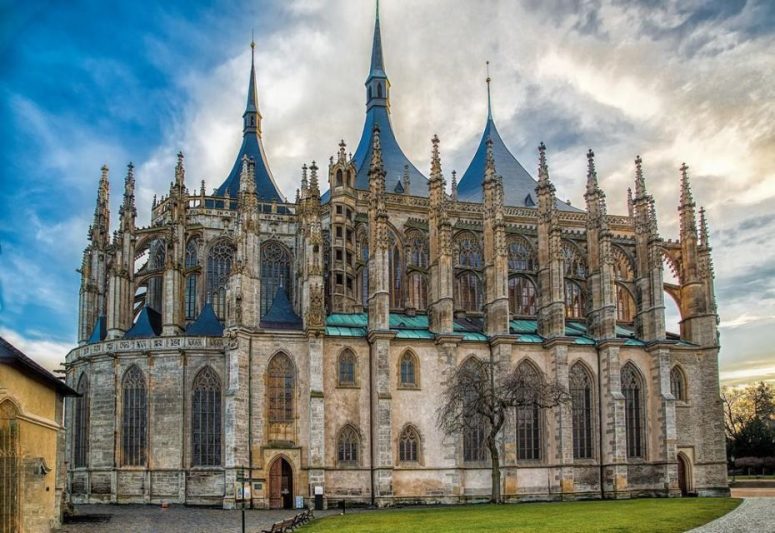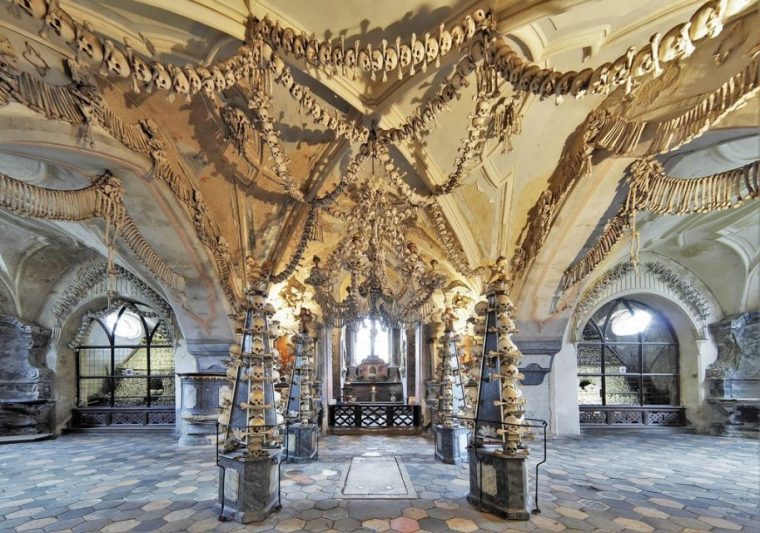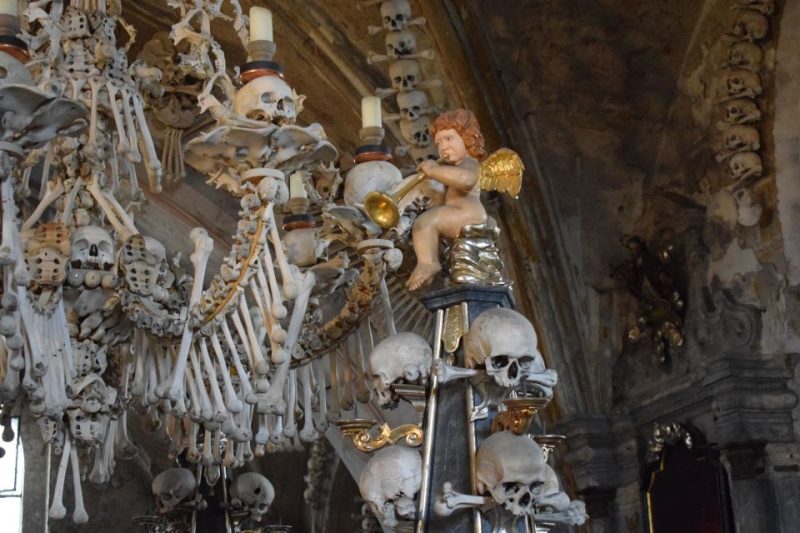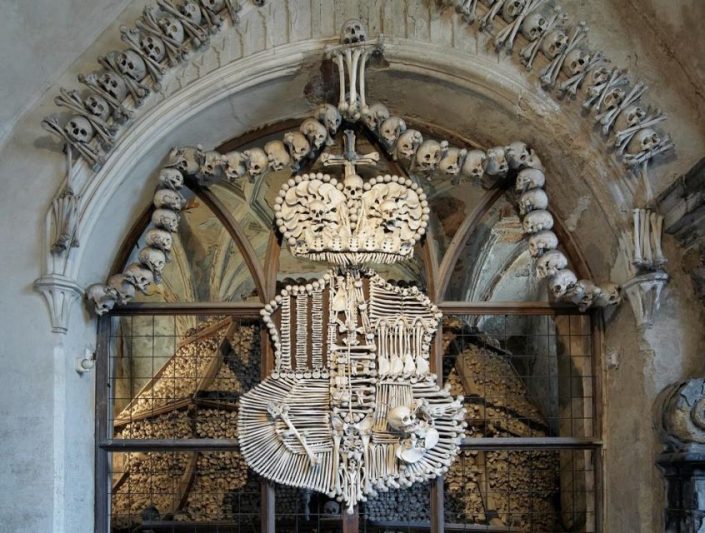Introduction to Kutna Hora Church of Bones
Brief History of the Sedlec Ossuary
“Kutna Hora Church of Bones” The Sedlec Ossuary, located beneath the Cemetery Church of All Saints in Kutna Hora, Czech Republic, has a history that dates back to the 13th century. Originally a small chapel, it gained significance when the Cistercian monastery in Sedlec began to use soil from the Holy Land to sprinkle over its cemetery. This act transformed the grounds into a coveted burial site, eventually leading to an overcrowding of graves.

Unique Architectural Features
What sets the Sedlec Ossuary apart is its macabre yet fascinating decor made entirely of human bones. The most striking features include a bone chandelier, coat of arms, pyramids of bones, and intricate garlands adorning the ceilings and walls. These elements showcase a morbid creativity that is both eerie and captivating.
Significance as a Tourist Attraction
The Sedlec Ossuary attracts visitors from around the world who are intrigued by its dark allure and artistic ingenuity. As a cultural landmark, it offers a unique insight into how mortality and religion intertwine to create a hauntingly beautiful experience for those who dare to explore its depths.
The Origins and History
Creation of the Ossuary in the 14th Century
In the 14th century, the Sedlec Ossuary in Kutna Hora, Czech Republic, was established. Originally a small chapel beneath the Cemetery Church of All Saints, it gained prominence as a burial site due to its connection with the Holy Land. Pilgrims brought soil from Golgotha, leading to an influx of burials.
Role of the Cistercian Monastery
The Cistercian monastery oversaw the Sedlec Ossuary, ensuring proper handling of the increasing number of human remains. The ossuary’s significance grew as it became a repository for the bones of thousands of individuals, with the monks taking on the responsibility of organizing and stacking the bones.
Transformation into an Artistic Monument in the 19th Century
During the 19th century, the Sedlec Ossuary underwent a remarkable transformation under the vision of František Rint. Rint, a woodcarver, was tasked with artistically arranging the bones, creating intricate decorations that would later become iconic symbols of the ossuary’s macabre beauty.

Architectural and Artistic Elements
Description of the Bone Chandelier and Coat of Arms
The Sedlec Ossuary in Kutna Hora, Czech Republic, houses some of the most macabre yet fascinating artistic creations. Among these is the bone chandelier, a striking centerpiece crafted entirely from human bones. Suspended from the ceiling, this eerie chandelier illuminates the chapel with an otherworldly glow, casting shadows that dance along the walls adorned with skeletal remains. In addition to the bone chandelier, visitors are captivated by the coat of arms displayed within the ossuary. Comprised of bones meticulously arranged to form intricate patterns, the coat of arms represents a unique fusion of art and mortality. Each bone carefully placed to create a symbol that transcends the physical material it is made of, inviting contemplation on the fragility of life and the inevitability of death.
Explanation of the Bone Pyramids and Garlands
As visitors wander through the Sedlec Ossuary, they encounter mesmerizing bone pyramids and delicate garlands intricately woven from human skeletal remains. These hauntingly beautiful structures, meticulously assembled by František Rint in the 19th century, showcase a harmonious blend of artistry and morbidity. The bone pyramids rise majestically, symbolizing both the transience of life and the enduring nature of the human spirit, while the garlands cascade elegantly, offering a poignant reminder of the inevitability of death.
Discussion of František Rint’s Artistic Vision
František Rint, the mastermind behind the artistic transformation of the Sedlec Ossuary, possessed a unique vision that breathed new life into the centuries-old bones. Through his meticulous arrangement of human remains, Rint sought to create a space that challenged conventional perceptions of mortality and spirituality. His artistic brilliance turned this ossuary into a place of contemplation, where visitors are confronted with the beauty and fragility of existence, inviting them to reflect on the interconnectedness of life and death.

Spiritual and Cultural Significance
Symbolism of Death and Resurrection in Christianity
In Christianity, death is often viewed as a transition rather than an end. The Sedlec Ossuary with its intricate bone decorations reflects this belief by juxtaposing death and resurrection. The macabre yet artistic displays of human bones serve as a reminder of mortality but also symbolize the hope of life beyond death.
Reflection on Mortality and the Transience of Life
As visitors walk through the eerie corridors of the ossuary, they are confronted with the stark reality of their own mortality. The carefully arranged bones force contemplation on the brevity of life and the inevitability of death. It’s a moment to reflect on the impermanence of existence and the fleeting nature of our time on earth.
Impact on Visitors’ Perceptions of Death
The Sedlec Ossuary has a profound impact on visitors, challenging their perceptions of death and inviting them to confront their fears and anxieties surrounding mortality. The artistic portrayal of death through bone chandeliers, pyramids, and garlands sparks contemplation and introspection, leading to a deeper understanding of the cycle of life and death.
Visiting the Kutna Hora Church of Bones
Practical Information for Tourists
When planning your visit to the Kutna Hora Church of Bones, also known as the Sedlec Ossuary, keep in mind that it is located approximately 1.5 hours by train from Prague, making it an accessible day trip. The ossuary is open daily from morning till evening, with slightly reduced hours on weekends, so be sure to check the official website for the most up-to-date information on opening times and any special events or closures. To enter the ossuary, visitors need to purchase tickets, which are reasonably priced and help support the ongoing preservation efforts. Guided tours are available for those who wish to delve deeper into the history and significance of this unique site, providing valuable insights that enhance the overall experience.

Best Times to Visit and Photography Tips
For a more intimate experience, consider visiting the Sedlec Ossuary during weekdays or early in the morning to avoid larger crowds. The lighting inside the ossuary can be dim, so bringing a camera with low-light capabilities or a tripod can help capture the intricate bone decorations without blur. Remember to be respectful while taking photos, as the Sedlec Ossuary is a place of reverence and reflection. Avoid using flash photography out of respect for the sanctity of the space and the delicate nature of the bone artwork.
Nearby Attractions in Kutna Hora
After exploring the macabre beauty of the Church of Bones, take some time to discover other attractions in Kutna Hora. Visit the stunning St. Barbara’s Church, a UNESCO World Heritage site known for its Gothic architecture, or explore the historic town center with its charming cobblestone streets and traditional Czech restaurants offering local cuisine. By immersing yourself in the rich history and culture of Kutna Hora, you can truly appreciate the depth and uniqueness of the Sedlec Ossuary within the broader context of this enchanting Czech town.
Conservation and Preservation Efforts
Current Challenges in Maintaining the Ossuary

Despite its enduring allure, the Sedlec Ossuary faces challenges in maintaining its delicate bone decorations. The sheer volume of visitors who flock to witness this macabre masterpiece poses a threat to the preservation of the ossuary. The constant exposure to humidity, temperature changes, and the oils from human skin can cause gradual deterioration of the bone structures.
Ongoing Restoration Projects
To combat the effects of wear and tear, ongoing restoration projects are crucial for preserving the integrity of the Sedlec Ossuary. Skilled conservators work meticulously to repair any damage, stabilize fragile bone structures, and ensure that the ossuary remains accessible for future generations to appreciate. These restoration efforts are essential to maintain the ossuary’s unique artistic value and historical significance.
Importance of Responsible Tourism
Responsible tourism plays a vital role in safeguarding the Sedlec Ossuary for years to come. Visitors are encouraged to respect the sacred nature of the site, follow designated pathways, refrain from touching the bone decorations, and refrain from taking photographs in restricted areas. By adhering to these guidelines, tourists can contribute to the long-term preservation of this extraordinary cultural landmark.
Conclusion: A Haunting Yet Beautiful Experience
Recap of the Ossuary’s Unique Appeal
The Sedlec Ossuary, located in Kutna Hora, Czech Republic, stands as a mesmerizing fusion of art and mortality. With its walls adorned with human bones intricately arranged into chandeliers, pyramids, and garlands, this site offers a haunting yet captivating experience for visitors worldwide.
Reflection on Its Place in Cultural Heritage
The Sedlec Ossuary is not merely a macabre display but a profound reflection of human mortality and the inevitability of death. As a unique artistic monument, it holds a significant place in cultural heritage by challenging traditional perceptions of life and death through its bone decorations crafted with intricate detail and solemn beauty.
Encouragement for Readers to Visit and Appreciate This Extraordinary Site
For those seeking a thought-provoking and visually striking experience, a visit to the Kutna Hora Church of Bones is a must. By exploring this extraordinary ossuary, visitors can contemplate the fragility of life, the cycle of existence, and the interconnectedness of humanity in a space that transcends the boundaries of conventional art and architecture.

Best information. Tank you for sharing.